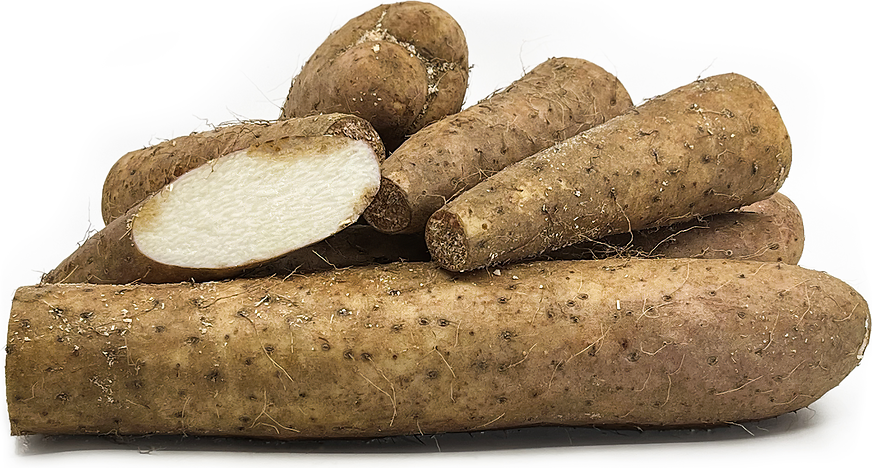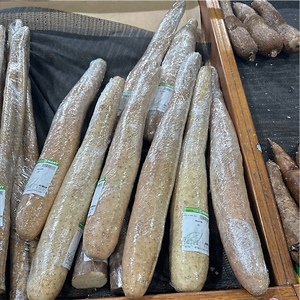


Nagaimo Mountain Yams
Estimated Inventory, lb : 0
Description/Taste
Nagaimo varies in size, depending on growing conditions, but is generally elongated, cylindrical, straight, and plump, averaging 50 to 80 centimeters in length and 4 to 6 centimeters in diameter. The yam should be uniform in thickness and may taper slightly, and the surface may occasionally be covered in flecks of sawdust due to storage methods. These flecks can be easily brushed off before use. The skin is semi-thick, textured, taut, and lightly rough, appearing in tan, ochre, and brown hues and enveloped in fine, wispy root hairs. Underneath the surface, the white flesh is dense, firm, and crisp, with a high water content. One of the distinct characteristics of Nagaimo is the flesh’s ability to become slippery and viscous when sliced or grated. The flesh releases a slimy liquid that gives the surface a silky consistency. This slippery feel is experienced when the yam is raw. Once cooked, the texture becomes fluffy, crisp, crunchy, or soft, depending on the heating method. Nagaimo is edible raw or cooked and has a neutral, mild, light, sweet, earthy, and subtly nutty taste.
Seasons/Availability
Nagaimo is harvested twice a year in Japan. The first harvest occurs in the winter, mainly November through December, and the second harvest is collected in the spring, from March to April.
Current Facts
Nagaimo, botanically a part of the Dioscorea genus, is a type of mountain yam belonging to the Dioscoreaceae family. The name Nagaimo translates from the Japanese words “naga,” meaning “long,” and “imo,” meaning “yam.” The descriptor was given to the yams for their elongated, slender, and cylindrical shape, and this yam is one of the most popular types sold in Japanese commercial markets. Classifications within the Japanese mountain yam grouping are somewhat challenging and confusing, as some names are used interchangeably between varying types. Yamaimo is a term typically used to describe the Japanese mountain yam category as a whole, and it is also sometimes used for a specific type of yam with dark brown skin and a thick, paste-like, sticky consistency. Nagaimo is a type of yam under the Yamaimo, or mountain yam category. What makes it challenging is that some people interchangeably use Yamaimo for Nagaimo, but they are distinct for this article’s purposes. There are many varieties of Nagaimo, and the yams are commercially cultivated in Japan and other regions of Asia, also known as Japanese yam, Japanese Mountain yam, Chinese yam, Tsukune yam, and Korean yam. The elongated yams are favored for their versatility in culinary and medicinal preparations. Nagaimo is one of the few types of yams that can be eaten raw or cooked, and their texture changes with various cooking methods.
Nutritional Value
Nagaimo is a source of fiber to regulate the digestive tract, potassium to balance fluid levels within the body, vitamin C to strengthen the immune system, iron to develop the protein hemoglobin for oxygen transport through the bloodstream, and other nutrients, including manganese and vitamin B1. In East Asia, Nagaimo has been incorporated into natural medicines as a way to lower blood pressure and increase digestion. The yams are thought to contain a digestive enzyme to keep the stomach from feeling heavy and sluggish, and a component called mannan is said to promote excretion and reduce the amount of sugars absorbed in the body. It is important to note that raw Nagaimo may cause irritation and itchiness in the skin and mouth of some individuals. The yams contain a pseudo allergen that makes the body think it is having an allergic reaction. This may not occur in all individuals, but caution and care should be taken before eating the yam raw.
Applications
Nagaimo has a light, mild, subtly sweet, and nutty taste suited for fresh and cooked preparations. The yams should be washed and peeled before use, and the flesh may quickly discolor once exposed to the air, but this does not affect the overall flavor. Placing sliced portions of the yam in vinegar water will help to slow discoloration. Nagaimo is popularly sliced into matchsticks and topped with dressings and soy sauce as a fresh salad. The sliced strips will have a crisp, light mouthfeel similar to an Asian pear and will also bear a distinct slippery consistency. Raw Nagaimo salads are often sprinkled with shisho leaves, bonito flakes, wasabi, or shredded nori for added flavoring. Nagaimo is also famously grated, shredded, or julienned, creating a slimy, silky, and slippery consistency called “tororo” in Japan. Tororo can be incorporated into a soup by mixing with dashi, miso, or soy sauce, or it can be combined with raw egg and folded into rice. It is also used in soba noodle dishes and okonomiyaki to make a fluffy batter for the savory pancake. In addition to tororo, Nagaimo is thinly sliced and placed as a delicate sushi garnish, or the yam can be cut and used as a topping on noodles, rice, and fried foods. Once Nagaimo is cooked, the sliminess disappears, and the flesh becomes fluffy, soft, crisp, or crunchy, depending on the cooking method. In Japan, Nagaimo is fried into tempura, sliced into rounds and sauteed, added to stir-fries, or steamed, boiled, or baked for varying consistencies. The yams can also be roasted over charcoal or simmered into hot pot dishes. Nagaimo pairs well with carrots, green beans, spinach, corn, cauliflower, and aromatics such as garlic, ginger, and onions. Whole, unwashed Nagaimo should be wrapped in newspaper, placed in a plastic bag, and stored in the refrigerator's vegetable drawer for 2 to 4 weeks. The yams can also be grated and frozen for extended use.
Ethnic/Cultural Info
Nagaimo is a part of a curious tale told throughout the Gunma prefecture in Japan. Legend has it that two famous mountains in the prefecture, Mt. Shia and Mt. Shirane, were plagued with demons. These demons would steal food and transport goods, eat children, and, in general, cause trouble that worried local communities. One day in May, a younger demon decided it was going to venture into a nearby mountain village to capture and eat a human. The demon spotted a farmhouse and peered into the window. In the kitchen, there was a woman cooking soup, and suddenly, she brought out a long, horn-like object and began grating it. The demon was shocked and said the object looked like a demon horn. The demon quickly returned to where he lived, breaking a part of his horn off to grate it. He was curious as to what the horn tasted like. While trying to grate it, other demons noticed his peculiar actions and began questioning why the demon was grating his own horn. The young demon told the others about the woman, and all the demons went to the window in her house to see for themselves. In the window, they saw the woman eating with her husband. The husband wanted seconds of the food, and the woman took out a basket filled with long, tan objects that again looked like demon horns. The demons were startled and eventually fled the area, afraid the humans would begin hunting them for their horns, finally leaving the mountains free of troublesome occurrences. The horn-like objects in the story are said to be Nagaimo, and the woman was grating the yams to make a traditional soup. This folk story led many families within the Guma prefecture to grow Nagaimo, as it is thought the elongated yams helped ward off demons.
Geography/History
Nagaimo is the Japanese name for a yam species originating in China. The species is a descendant of ancient yams that were thought to have been present since prehistoric times in the Yunnan region of Southwestern China. The yams were utilized for medicinal and culinary purposes. Over time, the species was spread into Northern China and was later introduced to Korea and Japan. During this expansion, yams were selectively bred and improved each growing season to create crops with favored characteristics. In China, the yams were generally referred to as Chinese yams, and the species was thought to have been carried into Japan sometime during the Heian period, but this is mostly a hypothesis without concrete records. After they arrived in Japan, the yams became known as Nagaimo and were grown beginning in the late Jomon period, around 8000 BCE and after. Widespread Japanese commercial production occurred around the 17th century, and the elongated yams became a common, everyday ingredient. Today, Nagaimo is primarily grown in Japan's Hokkaido, Aomori, Nagano, Tohoku, and the Chubu high-cold regions. It is also grown in tropical to subtropical regions of East Asia and is sold domestically and exported to markets worldwide.








